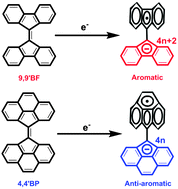High open circuit voltage organic photovoltaic cells fabricated using 9,9′-bifluorenylidene as a non-fullerene type electron acceptor†
Abstract
We have found that 9,9′BF can be used as an electron acceptor for P3HT-based OPVs while similar devices using 4,4′BP do not show any photovoltaic effect. This can be related to the respective aromaticity and antiaromaticity of the reduced forms of 9,9′BF or 4,4′BP. The OPV device fabricated using P3HT and 9,9′BF exhibited a PCE of 2.28% with a Voc of 1.07 V, a Jsc of 5.04 mA cm−2, and a FF of 0.42.


 Please wait while we load your content...
Please wait while we load your content...